ISSN 2348-1196 (print)
International Journal of Computer Science and Information Technology Research ISSN 2348-120X (online) Vol. 8, Issue 2, pp: (10-16), Month: April - June 2020, Available at: www.researchpublish.com

ISSN 2348-1196 (print)
International Journal of Computer Science and Information Technology Research ISSN 2348-120X (online) Vol. 8, Issue 2, pp: (10-16), Month: April - June 2020, Available at: www.researchpublish.com
1Taniya Chaudhary, 2Shivang, Sakshi Tyagi, 3Riya Beniwal, 4Vishal Choudhary
1,2,3,4 Department of Computer Science and Engineering, MIET, Meerut {taniya.chaudhary.cs.2016, shivang.cs.2016, riya.beniwal.cs.2016, sakshi.a.tyagi.cs.2016, vishal.choudhary}@miet.ac.in
Abstract: This concept comes for smart cities there is a requirement for the smart waste management system. The idea of waste monitoring system is for the residents, collage, hospitals and bus standpoints. Environment difficulties are raised up by modern cities for garbage collection. The main problem all over the world mainly in the well developed countries is management of waste/trash. As an existing solution we have the garbage collection we have the garbage collection vans which comes to various areas on weekly basis without any knowledge of the existing garbage content of the area and thus the garbage is littered around leading to various diseases in the area. This proposed system presents a smart dustbin with an advantage of cost effectiveness. Where there is large population there will be large garbage in that area. This system is based on IOT devices to observe a threshold level of the dustbin and gives a SMS warning using a GSM module to the authorities. Finally, the system is proposed effectively with a satisfactory global cost for the proposed application. The system performance was found acceptable according to the obtain experiment output.
Keywords: Ultrasonic sensors, Arduino Uno board, smart waste management, Global system for mobile communication (GSM).
Environment difficulties are raised up by modern cities for garbage collection. Main problems with waste management is overflowing of dustbins at public places which causes emission of gases from the dustbins and it leads to many health problems [3]. The problem all over the world mainly in the well developed countries is management of waste/trash [1]. Growing population, growing standards of living and life-style, economic growth, and manufacture and consumption of the products are acting in concert to generate progressively larger quantities of wastes/garbage, and this in turn is generating thoughtful problems of their management [7]. Therefore, smart waste management systems became necessary for cities/states/countries whose main purpose is to manage means, cost, time and mainly to the hygiene of the city or you can say the locality. Currently, the inclination is shifting towards smart systems and internet of things (IOT) solutions to overcome common problems such as waste management issues [4]. Improving the process of waste gathering is the main purpose of smart solutions. In this project we examine the traffic of a city and indirectly through which we examine the population of the area and hence, the possibility of collection of garbage in the particular locality. We had taken a city Meerut for analysing the traffic/Population. Meerut’s poor rank of 336 in Swachh Survekshan 2017 has encouraged the municipal body to take an ideal waste management system, inspired by Chhattisgarh’s Ambikapur but still there is less management of the waste and management is most important. Meerut city has population of 1,305,429; its urban population is 1,420,902, so we can say that Meerut city has good population For this we design a smart device that can detect the level of the garbage/waste in the dustbin and send the alert message to the concern authority.
If the dustbin is full (75% of the dustbin is filled with the waste) at a certain level. Dustbins are provided with a sensor (ultrasonic sensors) which helps in tracing the level of the dustbin [2]. When the dustbin is full of waste at a certain level i.e. 75% full of garbage then the alert SMS (message) is sent to the authorities. The smart bins concept is shown in the below Fig-1:
ISSN 2348-1196 (print)
International Journal of Computer Science and Information Technology Research ISSN 2348-120X (online) Vol. 8, Issue 2, pp: (10-16), Month: April - June 2020, Available at: www.researchpublish.com
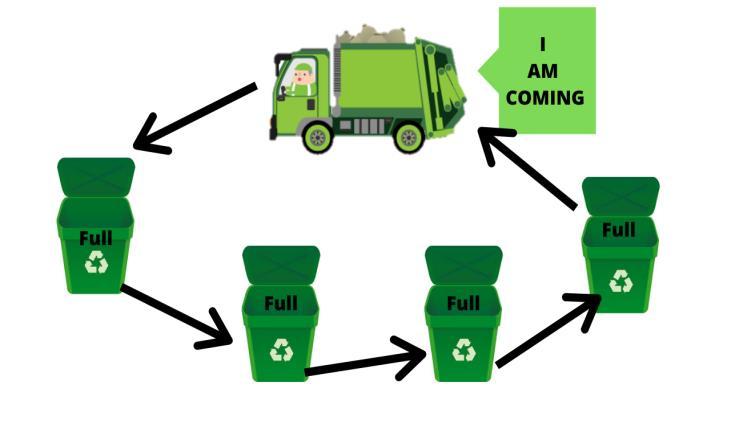
Waste management is the motion and arrangements needed to manage the garbage [5]. So this can be done by applying the IOT based smart waste management system. One of the reason of using smart waste management system is less proficiency and coverage to the city waste management using IOT technology and also lack of technical and trained manpower [8].
This project will provide a proposal for the smart waste management, then describe the usage of the hardware’s and there interfaces with each other. Fig-2 is briefly showing the E-Waste cycle. The software is then described and explained as a flow diagram. Given below figure shows the basic operation of system. In this firstly we predict the traffic using GPS system of a locality. Where there is large traffic this implies that there is large traffic means large population. And large population means large garbage and where there is large garbage when we need garbage bins or you can say dustbins over there. To build that smart system/device, system structural design and explained design of system, to execution process using Arduino tools. In the smart garbage collector, hardware’s comprises of Arduino UNO r3, GPS module, GSM sim900a module, Ultrasonic sensors, a power supply and connecting wires. When a particular verge of garbage level in the dustbin is reached, the GSM module will sent the alert SMS (message) to the concern authority.
Fig 2: E-waste Cycle
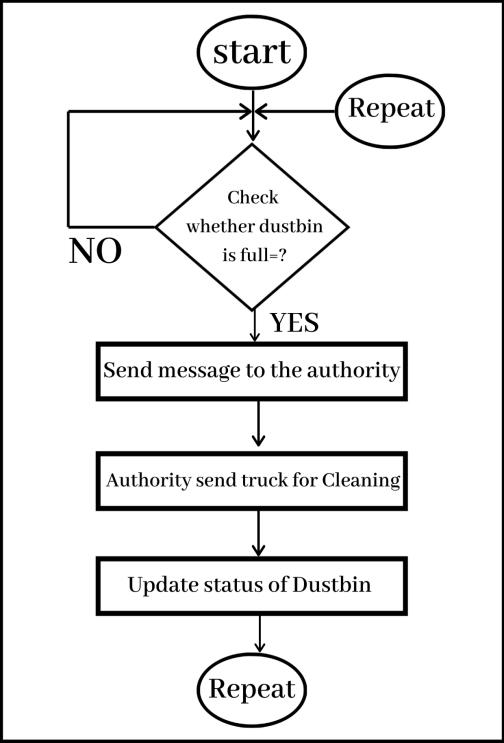
ISSN 2348-1196 (print)
International Journal of Computer Science and Information Technology Research ISSN 2348-120X (online) Vol. 8, Issue 2, pp: (10-16), Month: April - June 2020, Available at: www.researchpublish.com
Through above flow diagram, we will easily understand how everything is working in the in this project.
The hardware requirements for the system are as follows:
2.1.1 Ultrasonic Sensors: The Ultrasonic Sensor transmits a high-frequency sound pulse and then times how long it takes for the echo of the sound to reflect back.
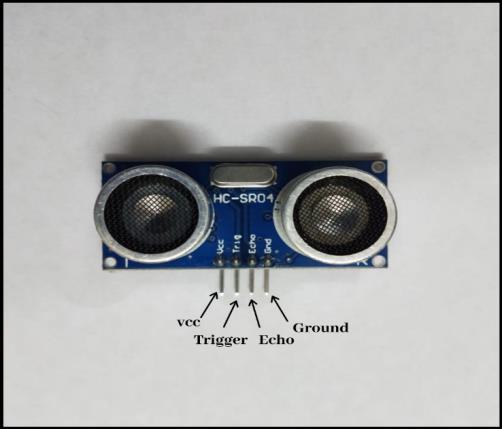
The sensor has 2 openings on its front see in Fig 3. One opening of ultrasonic sensor called transmitter, transmits ultrasonic waves, the other receives them. The speed of sound is approximately three hundred forty one (341) meters per second in air. The ultrasonic sensor uses time difference between sending and receiving the sound pulse to determine the distance of object from sensor. To calculate distance, the mathematical equation used is:
Distance = (Time x Speed of Sound)/2
Time = the time between sending and receiving sound pulses. To measure the distance to an object, the time from transmission of a pulse from transmitter to reception is calculated and converted into arrange by knowing the speed of sound, which for simple sensors may be just energy measurement [9]. It is then display to some form of decision device that calls the output either the required signal or noise. This result device may be an operative with a display, or in some systems by software also.
2.1.2 GSM Modem: GSM Modem: A GSM module or a GPRS module is a chip or circuit. This is used for communication and provides interface with mobile device or computers and a GSM or GPRS system. GSM Modem can accept any GSM network operator on any SIM card and work just like a mobile phone with its own unique phone number. Advantage of this modem (In Fig 4) is that it is used for communicate and establish embedded applications. Applications like SMS Control, data transfer, remote control and logging can be advanced easily using GSM as shown below.
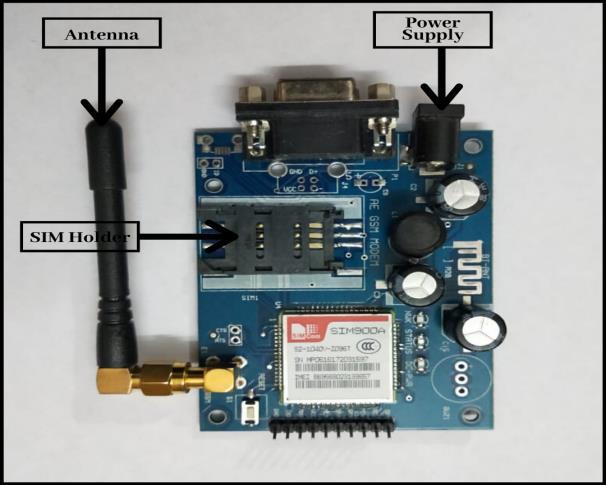
ISSN 2348-1196 (print)
International Journal of Computer Science and Information Technology Research ISSN 2348-120X (online) Vol. 8, Issue 2, pp: (10-16), Month: April - June 2020, Available at: www.researchpublish.com
The modem is connected to Arduino Uno R3 through RS232 port or any other. It is basically used for send and receive SMS (messages) or voice calls through an unknown sim. It can also be used in GPRS mode to connect to the internet and do many applications for data logging and control, this is specially used to enhance the system working. This GSM sim900a modem is flexibly integration to RS232 applications. This supports features like Voice, SMS, Data/Fax, GPRS and integrated TCP/IP stack.
2.1.3 Arduino UNO r3: The Fig 5 shows the Arduino Uno r3. It is an open-source microcontroller board based on the Microchip ATmega328P microcontroller and developed by Arduino [9].
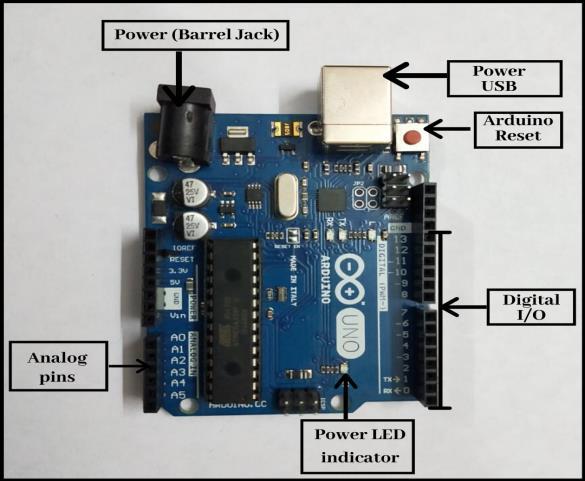
The board is consists of two types of pins, one is digital (14 digital pins) and second is analog I/0 (input/output) pins (6 analog pins) that may be connected to other hardware’s and other circuits using connecting wires. The board is code able (programmable) with the Arduino IDE (Integrated Development Environment) interface through a type B USB cable to upload the code onto the Arduino. It can be energised by the USB cable or by an external 9V (volt) battery, though it accepts voltages between 7 and 20 volts. It is also similar to the Arduino Nano and Arduino Leonardo. The hardware reference design is administered under a Creative Commons Attribution Share-Alike 2.5 license and is available on the Arduino official website. Layout and production files for some versions of the hardware like Arduino are also available.
2.1.4 Jumper Wires: A jumper wire is an electrical wire and group of then is known as cable with a connector pin.
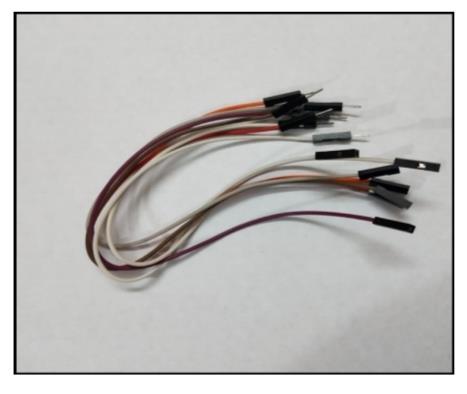
On Jumper wires, each end which is normally used to interconnect the components of a breadboard or other test circuit, internally or with other components without soldering. Individual jumper wires are fitted through the end connectors to the components pins or to the breadboard. Jumper wires generally are of two type one is whose both end connectors are different, they are named as male-female, male-male wires.
ISSN 2348-1196 (print)
International Journal of Computer Science and Information Technology Research ISSN 2348-120X (online) Vol. 8, Issue 2, pp: (10-16), Month: April - June 2020, Available at: www.researchpublish.com
2.2.1 Arduino IDE: The Arduino is open source Integrated Development Environment or Arduino Software(s/w) (IDE). Arduino IDE is a software(s/w) which helps user as it provides coding platform for codes for Arduino. A text editor for programing/coding for Arduino, an output console, a toolbar for some collective functions and sequence of menus.
2.2.2 Writing Sketches: Programs coded using Arduino Software (IDE) are known as sketches. These codes were inscribed in the Arduino text editor and should be save with .ino file extension. The message console provides observation while receiving, sending out data and also displays errors if any in the program or code i.e. sketches. The output console shows written sketches output through Arduino Software (IDE). The right. The toolbar buttons helps to verify and upload code on to the Arduino, create, open, and save sketches on to the software(s/w). Language used to code in Arduino is user friendly that can be called from your code.
The system consists of two parts, one is the detection of garbage level in the dustbin and the second is send the alert SMS (message) to collect the garbage to the corresponding authorities through GSM. In below block diagram the structure of the system is shown. Through this block diagram we can easily understand how the proposed system is implemented. There are 2 ways for interfacing GSM module to Arduino Uno r3. In any case, the interfacing between GSM module and Arduino Uno was serial, so we will supposed to adopt serial pins of Arduino (Rx and Tx). So if we are interfacing in such way then we will join the Tx (GSM module) to Rx(Arduino) and Rx(GSM module) to Tx(Arduino) i.e. Tx(GSM) –> Rx(Arduino) and Rx(GSM) –>Tx(Arduino). At last joining the GND pin of both Arduino and GSM module with each other. This is the way of connecting GPS module to Arduino.
• GND is the Ground Pin and needs to be join to GND pin onto the Arduino.
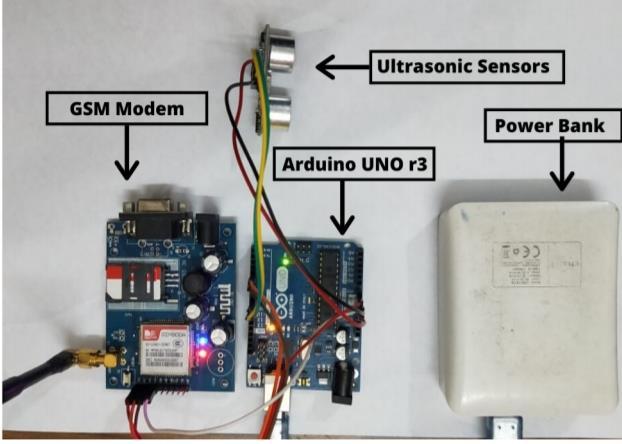
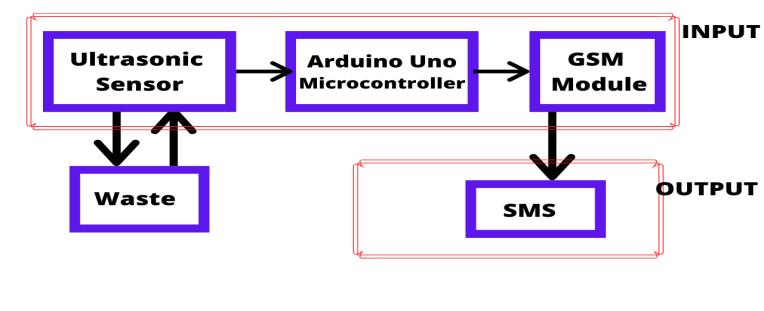
• TxD (Transmitter) is used for serial communication.
• RxD (Receiver) is used for serial communication.
• VCC (Voltage collector to collector) provides power for the module. You can directly connect it to the 5V (5 volt) pin on the Arduino.
ISSN 2348-1196 (print)
International Journal of Computer Science and Information Technology Research ISSN 2348-120X (online) Vol. 8, Issue 2, pp: (10-16), Month: April - June 2020, Available at: www.researchpublish.com
The ultrasonic sensor is sensing the level of the waste present in the dustbin and then the status of the waste is send to First the municipal authority whenever it is exceeding the threshold.
First message will be sent when the bin is filled upto 50%.
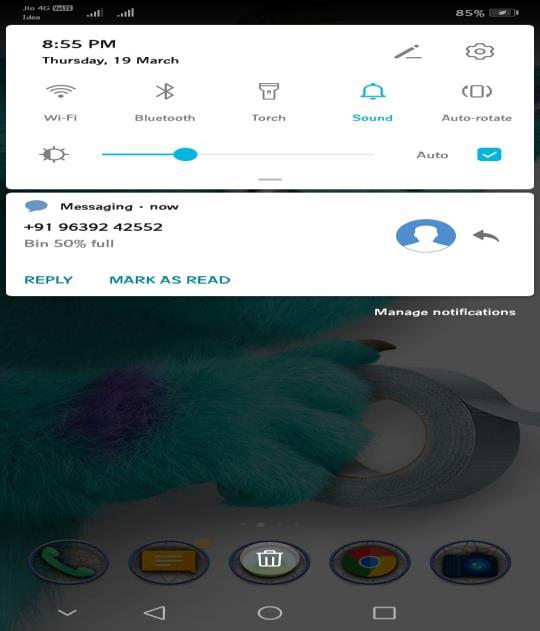
The last message will be sent when bin is filled to 90%.
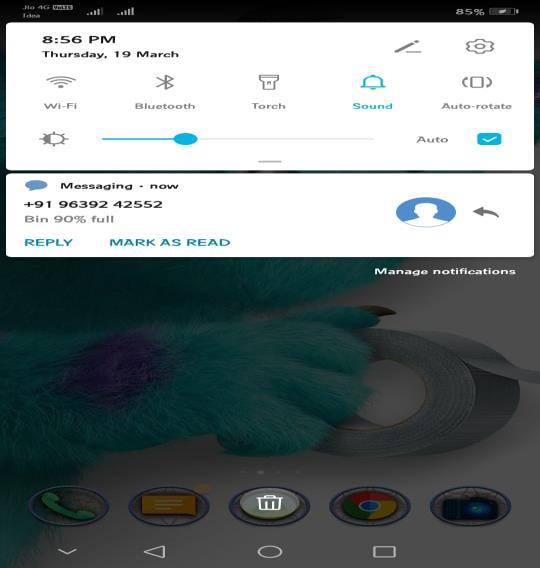
This smart waste prediction and management system helps us to reduce the pollution. Most of the times garbage dustbins is full and got overflow and many of the street animals like dogs, cats, cows enters inside or near the dustbin and even the birds also try to take out garbage from the dustbin in search of food. This project helps to avoid such situation in the particular area and the message can be sent directly to the concern person who used to collect the garbage from that area. To enhance this we going to analyse the traffic, where there is large traffic there is large population hence we can analyse where we should place the dustbins.
ISSN 2348-1196 (print)
International Journal of Computer Science and Information Technology Research ISSN 2348-120X (online) Vol. 8, Issue 2, pp: (10-16), Month: April - June 2020, Available at: www.researchpublish.com
[1] Vikrant Bhor, “Smart Garbage management system”, International Journal of Engineering Research and Technology(IJERT)(2009)
[2] Akanksha Reddy, Dr. Nukala Srinivasa Rao, “Smart waste Collection trash overflows Indicator using IOT”, International Journal for Research in Applied Science & Engineering Technology (IJRASET)(2017)
[3] S. Dugdhe, P. Shelar, S. Jire, and A. Apte, “Efficient Waste Collection System,” 2016 Int. Conf. Internet Things Appl. (IOTA)(2016)
[4] Guerrero, Lilliana Abarca, Ger Maas, and William Hogland. “Solid waste management challenges for cities in developing countries.” Waste management 33.1(2013)
[5] Narayan Sharma, “Smart bin implementation for smart cities” International Journal of scientific & Engineering Research, volume 6 (2016)
[6] John A. Stankovic, “Research directions for the internet of things”, IEEE.
[7] Ashwani Kumar, Phool Kumar, “E-Waste Management in India: Issues and Options”, IJLESS International Journal of Languages, Education and Social Sciences, vol. 02 (2012).
[8] Mahesh C. Vats, Santosh K. Singh, “Status of E-Waste in India-A Review”, International Jornal of Innovative Research in Science, Engineering and Technology, vol. 03 (2014).
[9] Mohammad, Tarek, “Using ultrasonic senors for distance measurement.” World Academy of Science, Engineering and Technology 51 (2009)
[10] Traffic analysing of Meerut city, 2019, [online] Available: https://www.viamichelin.com/web/Traffic/Traffic_infoMeerut- -Uttar_Pradesh-India.
[11] Solid Waste Management in developed countries – A case study of Turkey, [online] Available: https://link. springer.com/chapter/10.1007/978-94-010-0940-9_3.